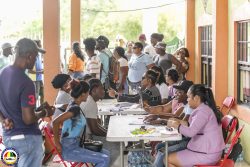The rainy season begins in earnest in early April and the hurricane season in early June, according to the World Meteorological Organisation (WMO). Both can be deadly.
“If a hurricane hits Haiti head on, the loss of life will be severe and every temporary housing camp will be wiped out,” Cameron Sinclair, co-founder of non-profit design and building group Architecture for Humanity, wrote in a blog.
Margareta Wahlstrom, U.N. Special Representative of the Secretary-General for Disaster Risk Reduction in Geneva, offers a similar warning for the Haitian capital.
It bore the brunt of the Jan. 12 earthquake, which has killed up to 300,000 people.
“Port-au-Prince is built on vulnerable small slopes and mountains. With the rains, these slopes start softening up and cause mudslides like we have seen in the past, causing schools to collapse and more deaths,” she told Reuters AlertNet.
A series of storms in Haiti in 2008 already showed the extent of damage they can cause, even to sturdy buildings. More than 800 people were killed and nearly 1 million left homeless or in dire need of help.
Haiti is extremely vulnerable to floods and mudslides because most of its hillsides have been stripped bare.
Cutting down trees to make charcoal to sell for fuel is a last resort for many rural Haitians who have no other income between harvests.
There is no talk in the Haiti aid community of building enough durable housing before the storms start and no mention so far of evacuation plans in case of floods or mudslides.
“We have a huge challenge in terms of just providing emergency shelter — something that we feel that if we put all of our weight behind, as we are doing right now, we will be able (to do),” said Kristen Knutson, a spokeswoman for the U.N. office that is coordinating the international relief effort, in a telephone interview from Haiti.
She added that aid groups were for now focusing on providing plastic shelter materials to earthquake survivors and that more robust housing would be needed in the longer-term.
The International Federation of Red Cross and Red Crescent Societies (IFRC), which is coordinating all shelter-related aid work in Haiti, is so far building only one model transitional house and hopes construction of more houses will begin before the rainy season.
“MINIMAL PROTECTION”
Beyond distributing waterproof shelter materials, aid agencies are also working to improve sanitation and health care — all essential in wet conditions which help infections spread.
“Neither tents nor tarpaulins, however, will provide more than minimal protection from the Haitian rainy season which peaks in May, when Port-au-Prince gets an average 230 mm of rain and sometimes as much as 50 mm in two hours.
The hurricane season, which begins later in the year, is of special concern,” IFRC said in a statement.
When asked for more information, including on evacuation plans, an IFRC spokesman in Haiti declined to comment further.
The WMO has also been asking Haitian authorities and some aid agencies on the ground whether it would be possible to anticipate floods and move the displaced people — many of whom have camped out in low-lying planes and near the sea — to safer ground, said Maryam Golnaraghi who heads the disaster risk reduction programme at the U.N. weather body.
“I do not know the answer to that,” she told Reuters AlertNet. Before any evacuation can begin, reliable and consistent forecasts of extreme weather must reach the government and relief groups quickly.
In Haiti, that is difficult as the earthquake shattered its weather stations and now several countries are supplying meteorological information to the country.
To prevent any confusion, the WMO is working with Haiti’s authorities to ensure that all weather forecasts are channelled through Haiti’s single official meteorological service.
Another challenge is disseminating the information, now that only a fifth of all media in Haiti are working, Golnaraghi said.
As those aims are achieved one by one, Haiti will become better prepared for the stormy season. But time is short and the number of people at risk enormous.
“We recognise that this is minimal perfection,” said Knutson from the U.N. Office for the Coordination of Humanitarian Affairs (OCHA).






